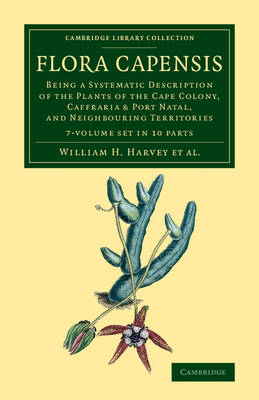Cambridge Library Collection - Botany and Horticulture
3 primary works • 4 total works
Volume 1
Flora Capensis: Volume 1, Ranunculaceae to Connaraceae
by William H Harvey and Otto Wilhelm Sonder
Published 24 July 2014
This seminal publication began life as a collaborative effort between the Irish botanist William Henry Harvey (1811–66) and his German counterpart Otto Wilhelm Sonder (1812–81). Relying on many contributors of specimens and descriptions from colonial South Africa - and building on the foundations laid by Carl Peter Thunberg, whose Flora Capensis (1823) is also reissued in this series - they published the first three volumes between 1860 and 1865. These were reprinted unchanged in 1894, and from 1896 the project was supervised by William Thiselton-Dyer (1843–1928), director of the Royal Botanic Gardens at Kew. A final supplement appeared in 1933. Reissued now in ten parts, this significant reference work catalogues more than 11,500 species of plant found in South Africa. Opening with a preface which clarifies the project's original scope, Volume 1 covers Ranunculaceae to Connaraceae.
Volume 2
Flora Capensis: Volume 2, Leguminosae to Loranthaceae
by William H Harvey and Otto Wilhelm Sonder
Published 24 July 2014
This seminal publication began life as a collaborative effort between the Irish botanist William Henry Harvey (1811–66) and his German counterpart Otto Wilhelm Sonder (1812–81). Relying on many contributors of specimens and descriptions from colonial South Africa - and building on the foundations laid by Carl Peter Thunberg, whose Flora Capensis (1823) is also reissued in this series - they published the first three volumes between 1860 and 1865. These were reprinted unchanged in 1894, and from 1896 the project was supervised by William Thiselton-Dyer (1843–1928), director of the Royal Botanic Gardens at Kew. A final supplement appeared in 1933. Reissued now in ten parts, this significant reference work catalogues more than 11,500 species of plant found in South Africa. Containing the remaining polypetalous orders of the Calyciflorae, Volume 2 covers Leguminosae to Loranthaceae.
Volume 3
Flora Capensis: Volume 3, Rubiaceae to Campanulaceae
by William H Harvey and Otto Wilhelm Sonder
Published 24 July 2014
This seminal publication began life as a collaborative effort between the Irish botanist William Henry Harvey (1811–66) and his German counterpart Otto Wilhelm Sonder (1812–81). Relying on many contributors of specimens and descriptions from colonial South Africa - and building on the foundations laid by Carl Peter Thunberg, whose Flora Capensis (1823) is also reissued in this series - they published the first three volumes between 1860 and 1865. These were reprinted unchanged in 1894, and from 1896 the project was supervised by William Thiselton-Dyer (1843–1928), director of the Royal Botanic Gardens at Kew. A final supplement appeared in 1933. Reissued now in ten parts, this significant reference work catalogues more than 11,500 species of plant found in South Africa. Containing orders of the Calyciflorae with a monopetalous corolla and an inferior ovary, Volume 3 covers Rubiaceae to Campanulaceae.
Flora Capensis 7 Volume Set in 10 Pieces
by William H Harvey, Otto Wilhelm Sonder, and William T Thiselton-Dyer
Published 31 July 2014
This seminal publication began life as a collaborative effort between the Irish botanist William Henry Harvey (1811-66) and his German counterpart Otto Wilhelm Sonder (1812-81). Relying on many contributors of specimens and descriptions from colonial South Africa - and building on the foundations laid by Carl Peter Thunberg, whose Flora Capensis (1823) is also reissued in this series - they published the first three volumes between 1860 and 1865. These were reprinted unchanged in 1894, and from 1896 the project was supervised by William Thiselton-Dyer (1843-1928), director of the Royal Botanic Gardens at Kew. A final supplement appeared in 1933. Reissued now in ten parts, this significant reference work catalogues more than 11,500 species of plant found in South Africa. Volume 1 opens with a preface which clarifies the project's original scope.

